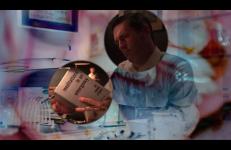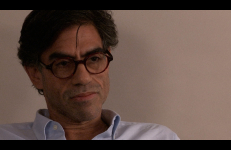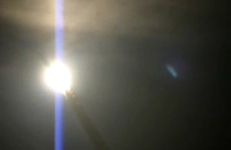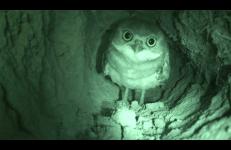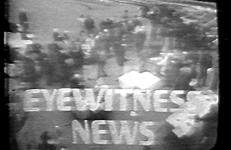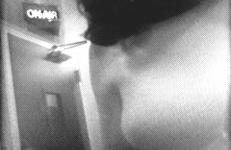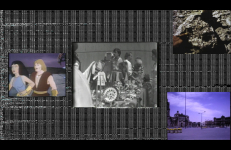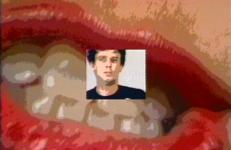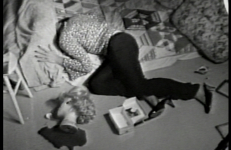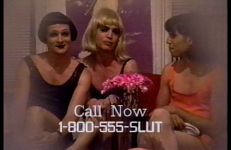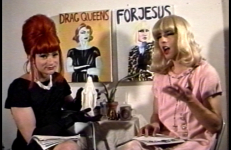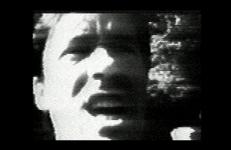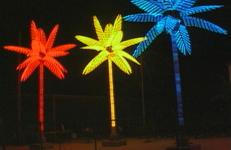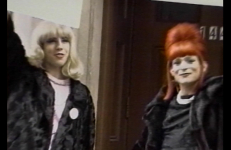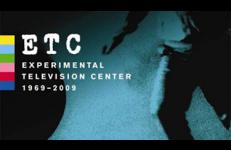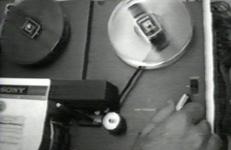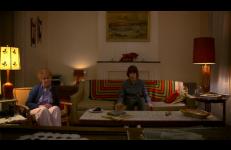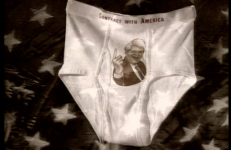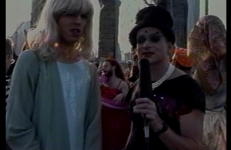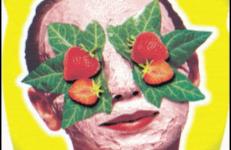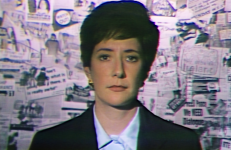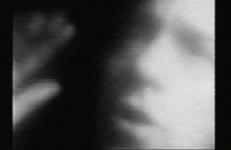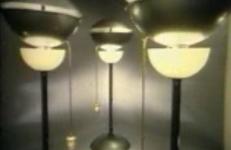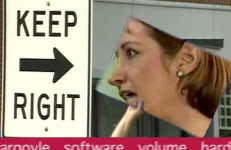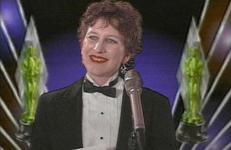Book Report explores themes of sexual assault, the weaponization of language, and the futility of escape. It combines short sequences of Mad Men's Don Draper with relevant facts about the 2016 presidential campaign — including a history of the hashtag #trumpbookreport and notes on a payment to the mysteriously named “Draper Sterling” ad agency. A choral voice-over, drawn from the infamous Access Hollywood transcript, revises the misogynist “locker room talk,” turning it against the original speaker.
Television
Gregg Bordowitz is a writer, AIDS activist, and film and videomaker. His work, including Fast Trip, Long Drop (1993) and Habit (2001), documents his personal experiences of testing positive and living with HIV within the context of a personal and global crisis. His writings are collected in The AIDS Crisis is Ridiculous and Other Writings:1986-2003.
A video that observes the thrill, terror, and boredom found in watching mass spectacles, and the unexpected loneliness when you miss them. This video speaks of both the power and the failure of the televised experience to bind us to one another.
Burrow-Cams features footage from cameras that have been placed inside underground animal habitats (dens, burrows, etc.). Animals showcased include: burrowing owl, black-footed ferret, porcupine, badger, prairie vole, swift fox, deer mouse, and black tailed prairie dog.
Note: This title is intended by the artist to be viewed in High Definition. While DVD format is available to enable accessibility, VDB recommends presentation on Blu-ray or HD digital file.
Showcasing local documentaries made on 1/2" equipment, Changing Channels was a weekly alternative video magazine produced by University Community Video (UCV) and aired on public television station KCTA, Minneapolis. In The Business of Television News, which aired as part of the Changing Channels series, several area television news operations were asked to examine their objectives and their markets.
The Videofreex had several experiences with the Black Panther Party, including interviewing Illinois Chapter Deputy Chairman Fred Hampton and New Haven Minister of Information Cappy Pinderhughes. In this tape, recorded on March 5th 1971, the Videofreex one-person camera crew Bart Friedman is walking the hallways of CBS, trying to find out where a video statement by Black Panther Eldridge Cleaver is located. The shots are mostly close up on people’s torsos and there is some image loss, but the sound is intact. The tape has an eerie espionage feel.
Colonial Transfer vindicates the eidetic chasm that produced the arrival of television in the cinema as well as the absorption, transduction and digital expansion of television and historical film archives, all linked by the negentropic outburst of a source code in trance. This is the state of ever-expanding media landscape in the post-covid quarantine. Our state of space-time.
An insert square of a man running is superimposed over a magnified mouth that speaks to him — first in nurturing encouragement, then with a no-win Mommie Dearest kind of criticism. Originally presented as an installation on six monitors, Deadline focuses on “the stress man feels in the urban environment,” using a range of digital video effects to stretch, compress, flip and fracture the image.
In this video, Brenda Sexual, Glennda Orgasm, and friends act out a drag queen murder mystery that takes place on their talk show. Later, they attend the Queer Fashion Army Invasion, a sit in of openly queer public fashion performance outside the Fashion Institute of Technology in Manhattan. Then, the pair arrives at a video store to discuss queer undertones of Hollywood films, like Grease, Rocky II, and Yentil.
In this episode of The Brenda and Glennda Show, Brenda and Glennda create a satire of 1990's infomercials. The video includes interviews and performances by Vaginal Davis, Bruce LaBruce, and Chris Teen.
An episode of The Brenda and Glennda Show, hosted by Brenda Sexual and Glennda Orgasm.
In this episode of The Brenda and Glennda Show, Brenda and Glennda comically debate changing the name of their show to Drag Queens for Jesus, in order to convert all the secular homosexuals to Christianity. They discuss topics like abortion and censorship from a drag queen perspective, exploring the hypocrisy and inherent bias of Christian ideals. Later, Brenda gets her nipple pierced in homage to Sandy Daley's Robert Having His Nipple Pierced (1971).
It’s the first day of autumn, and Gibbons can already smell death in the air. Leading us and his dog Woody on a walk through a cemetery, Gibbons voices his obsessive thoughts of death and destruction saying, “I want to be a leaf; I want to fall from a great height and crush whatever I land on.” Waxing weirdly philosophical, Gibbons satirically tries to impress the concept of mortality on his dog; the video, shot in Pixelvision, approximates his dog’s black-and-white vision.
The frenzied detritus of trading floors, smart weaponry and the religious right are woven through the petrochemical landscapes of Southeast Texas. This short video harangue questions land use policy as it serves the oil industry, patriotism as it absolves foreign aggression, and fundamentalism as it calcifies thinking.
Equal Rights for Unborn Drag Queens is a satirical short video in which Brenda and Glennda critique anti-abortion politics, homophobia, and religious fanaticism in the media. Interspersed between clips of right-wing news broadcasts is footage of Brenda having her nipple pierced, in an homage to Sandy Daley's Robert Having His Nipple Pierced (1971).
An episode of The Brenda and Glennda Show hosted by Brenda Sexual and Glennda Orgasm.
ETC: Experimental Television Center 1969-2009 is a five-DVD box set presenting the electronic media work of over one hundred artists who participated in the Center’s Residency Program during a 40-year period. The collection offers a look at the evolution of the unique artist-designed sound and image tools that are the hallmark of the Center’s studio, and provides a view into the constantly changing artistic processes and practices that have shaped the work over the years.
This video documents the history of U.S. community television and public access TV, using rare video clips from across the nation. Combining unique archival footage from the early days of cable, rediscovered footage from the 1/2" portapak era, and interviews with access pioneers, Everyone's Channel provides an illuminating overview of the people, ideas, and technological developments that helped make cable access a reality, and stresses the continuing need to see it as a vital necessity and right.
An homage to the death of the soap opera, The Evil Eyes is a 1960's era story of a grandmother faced with her mortality, a mother in mid-life crisis, and a son realizing his sexuality - a dysfunctional family whose unspoken angst manifests in the latest episode of their beloved supernatural soap opera, Before Dawn.
In response to the 1994 Republican campaign Contract with America that ushered in the first GOP House majority in over 42 years, Ligorano Reese screen printed men’s and women’s cotton briefs with the face of Newt Gingrich on the crotch and the Contract with America legislative agenda on the seat. The underwear became an overnight sensation when elected officials in Washington received them and became so infamous the Republican National Committee threatened the artists with copyright and trademark infringement.
In Fagtasia Solstice, Brenda and Glennda attend a Radical Faerie event in New York City to commemorate the Summer Solstice. Through interviews with Faeries and footage of their walk across the Brooklyn Bridge, the group proposes to reclaim the city as a safe space for queer people, and discuss reorienting queer consciousness toward spirituality.
An episode of The Brenda and Glennda Show, hosted by Brenda Sexual and Glennda Orgasm. Featuring the Radical Faeries. Thanks to Julie Clark and Dana Nasrallah.
Fantasy Suite was the last standard definition video I made from VHS tapes. Like WHS VHS #1, I made it to premiere at Roots & Culture’s Zummer Tapez, and speed manipulation figured heavily into its construction (the Bachelor material was not interesting or even tolerable at normal speed, but slowed down slightly, it became fascinating to me). Shana Moulton’s work was a strong influence on this video (I programmed my piece to play after hers in the Zummer mixtape), hence the animated facial masks and SkyMall imagery.
Broadcasters across Ireland and Britain have entered into a blackout strike. The workers are transmitting a programme bringing censored voices back onto the airwaves.
"In the late 1980s, as violence continues in the north of Ireland, censorship is increasingly being enforced on British and Irish television. In response, broadcasters have entered into a blackout strike, occupying several stations and transmitting a programme bringing censored voices back onto the airwaves."
In Final Exit, an aged one is confronted with his options in blunt terms. Does he want to drag out his existence, increasingly infirm and a burden to his caretakers, or go quietly before resentment overwhelms sentiment? Does he wish to go on living, the quality of his life increasingly diminishing, or be euthanized? Would he prefer cremation or burial? This video confronts the issues of mortality and advancing decrepitude that faces even the friskiest.
R.M. Fischer’s lamp sculptures, made from found industrial parts in a hybrid style of high-tech slickness and Baroque exaggeration suggested parodies of industrial commercials. The narration sounds like advertising hype but is actually composed from critical reviews of Fischer’s work. The slick, serious look of the final tape was accomplished in part by using a professional voiceover actor, a commercial photographer, and music composed for a brand-name commercial.
Framed is the second installment of the longer piece, Video Bites: Triptych for the Turn of the Century. Offering a series of visual metaphors discussing the ubiquity of the "frame" in contemporary life, Braderman uses her trademark chroma-key to juxtapose exterior landscapes with television clips, advertisements, and news footage.
Framed originally premiered as part of Video Bites: Triptych for the Turn of the Century in 1998; it was re-edited in 2017. Braderman co-directed Framed with Dana Master.
Silver directs and performs all the roles in this raucous and hilarious music video rendition of Lynyrd Skynyrd’s "Freebird", the infamous Southern rock anthem for an entire generation of 1970s male youth. In this spoof of straight mass culture, Silver flips ironically between roles; from a lesbian proudly proclaiming her sexuality at the Academy Awards, to an in-concert Coors-drinking Ronnie Van Zant, and, finally, to a black-lace lesbian lounge swinger celebrating the wild, colorful world of “out” visibility.




